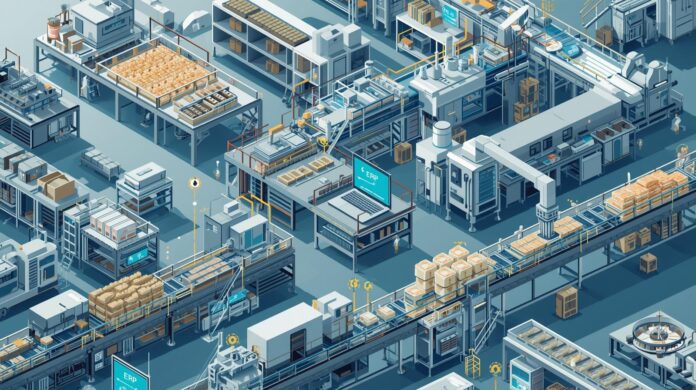
Key takeaways:
- Integration beats replacement: Industry experts increasingly recommend phased integration over “rip-and-replace” strategies, with integration delivering faster payback than full system replacement.
- Success requires strategy, not spending: Leading food manufacturers like Tyson Foods and Nestlé achieved breakthrough results by connecting existing equipment to modern platforms rather than starting over.
- The failure trap is avoidable: Most digital transformation pilots fail to scale because companies treat integration as an obstacle rather than recognizing it as the actual work of transformation.
Your production line has been running for 20 years. It works. Yet boardroom pressure for “digital transformation” has you considering scrapping everything for the latest smart factory technology. Before you sign that multi-million dollar replacement contract, consider this: digitally successful food manufacturers don’t have to replace their legacy systems. They’re integrating them.
According to a survey by the Institute of Food Technologists, 53% of food manufacturers struggle with legacy system integration challenges, making it the second-biggest barrier to digital transformation after cost. But this integration challenge isn’t a problem to overcome before transformation begins. It’s part of the transformation.
Why 70% of manufacturers get stuck in pilot purgatory
The food industry as a whole is aware of the need for digital transformation, but slow to achieve it. Research from TraceGains’ 2024 Digital Drag report found that 60% of food and beverage businesses remain “stuck in implementation” due to complexity and outdated approaches. Furthermore, nearly 70% of industrial firms can’t seem to get past the pilot stage of their digital transformation programs.
Why such widespread failure? Because most manufacturers fundamentally misunderstand what digital transformation requires. They treat it as a technology shopping spree instead of a strategic integration challenge.
“The idea that every technology implementation has to be a multi-year project staffed by external consultants is a holdover from another era,” explains Paul Bradley, Senior Director of Product Marketing at TraceGains. “The clock is ticking for food and beverage brands plagued by outdated ERP software and slow-moving consulting models that no longer serve the needs of today’s market.”
The consequence of getting it wrong is costly. Food manufacturers operate on notoriously thin margins and can’t afford endless pilot projects that never scale. But they also can’t afford to do nothing. The Food Safety Modernization Act (FSMA) 204 traceability rule requires compliance by July 2028, demanding real-time data capture that legacy systems alone can’t provide.
Integration success stories that prove the point
The manufacturers achieving breakthrough results share a common approach: they’re enhancing their legacy systems with modern capabilities rather than replacing them wholesale.
Take Tyson Foods, one of the world’s largest meat processors with $53.31 billion in 2024 revenues. The company faced a crisis with unreliable legacy servers causing production disruptions across more than 100 facilities. Rather than replacing everything, Tyson integrated its existing systems with Google Cloud Platform and deployed hundreds of thousands of Internet of Things (IoT) sensors throughout its plants. The first factory implementation took just 1.5 months.
“Directly connecting operations data to IoT data points and vice versa has allowed us to modernize and future proof at the same time,” the Tyson Foods team reported in their Google Cloud case study.
Similarly, Nestlé completed the world’s largest SAP S/4HANA upgrade in 2024-2025, but crucially, they integrated rather than replaced. The upgrade went live for 50,000+ users across 112 countries while preserving existing operations. The company built its IoT platform on top of legacy infrastructure, connecting everything from Nespresso coffee machines to smart pet products.
“Having a unified ERP backbone provides a common platform and data foundation that enhances visibility across the company,” explained Chris Wright, Nestlé’s Chief Information Officer. “With AI and automation, we can bring new products to market faster and operate more efficiently across our entire value chain.”
Even smaller manufacturers are finding success through integration. Uncle Crumbles, a 30-year-old gluten-free granola manufacturer, improved its Safe Quality Food (SQF) score from 87 to 99 by strategically integrating Oracle NetSuite ERP with existing production lines rather than replacing equipment. The company added robotic palletizers on a zero-capital expenditure model and connected scanner systems to legacy equipment, allowing them to bid on business previously impossible to fulfill.
The workforce and knowledge crisis makes replacement impossible
Food manufacturing equipment presents unique challenges that actually favor integration over replacement. Production lines represent massive capital investments and often contain specialized equipment designed for specific products or processes. A full replacement would eliminate decades of process optimization. It would also eliminate institutional knowledge overnight at a time when the industry already faces severe workforce shortages.
Charles A. Horth, CEO of Factora with two decades of experience implementing manufacturing execution systems (MES), argues forcefully against replacement strategies. “Given massive existing investments in physical, digital, and human resources — not to mention the pitfalls of radical change projects — the too-prevalent IIoT argument of rip-and-replace should R.I.P., ASAP,” he wrote in IndustryWeek.
Instead, successful manufacturers follow a proven integration architecture. They use the ISA-95 framework, which defines hierarchical levels from physical processes through enterprise planning, combined with OPC UA (Open Platform Communications Unified Architecture) as the communication backbone. This approach allows them to:
- Add IoT sensors to existing equipment without mechanical modifications
- Connect previously isolated systems using middleware as protocol translators
- Aggregate data from disparate sources for analysis
- Optimize operations based on insights without disrupting production
According to Pemeco Consulting’s 2024 analysis, typical ERP implementations have payback periods of 2 to 5 years, with 2.5 years being most common. In contrast, targeted integration projects can deliver returns much faster, particularly when focusing on specific pain points like quality tracking or predictive maintenance.
The road to integration, from assessment to scale
Based on patterns from successful implementations, here’s how food manufacturers should approach legacy system integration:
Phase 1: Assessment and quick wins (months 1-3)
Start with a network scan to identify where value lies across your facilities. Deploy core MES functionality and begin IoT sensor deployment on your highest-value equipment, typically where downtime is most costly or quality issues create the most waste. Focus on non-invasive approaches that don’t require reprogramming programmable logic controllers.
Phase 2: Integration and intelligence (months 4-8)
Connect quality management systems to production data and implement predictive maintenance on critical equipment. Deploy advanced analytics to identify patterns you couldn’t see before. Develop one or two “lighthouse” sites where you can prove concepts before scaling.
Phase 3: Optimization and scale (months 9-12)
Enable AI-driven optimization for scheduling and resource allocation. Implement digital twin capabilities for process simulation. Scale successful approaches across your network, using lessons learned from lighthouse sites.
McKinsey’s Global Lighthouse Network research emphasizes that success requires focusing on 5-7 high-impact, reinforcing use cases rather than scattered pilots. Prioritize based on value, not ease of implementation.
Food Manufacture UK reports that successful digital transformation typically follows a best-of-breed approach. As Josephine Coombe, Chief Commercial Officer at Nulogy, explains: “Successful digital transformation strategies typically leverage a best-of-breed approach, i.e., finding the right, purpose-built solution for the particular job at hand.”
Building your defense against cyber attacks
Legacy systems weren’t designed with cybersecurity in mind, creating vulnerabilities that integration must address. Rather than replacing vulnerable systems, focus on implementing defense-in-depth strategies:
- Network segmentation following the Purdue model, with demilitarized zones (DMZs) between information technology (IT) and operational technology (OT) layers
- OT-specific security monitoring that understands industrial protocols
- Zero-trust architecture with multi-factor authentication for system access
- Compensating controls when legacy systems cannot be patched
Recent attacks on major food companies including JBS (2021) and Dole (2023) demonstrate the threat is real and growing. The Elisity 2025 cybersecurity report emphasizes that food manufacturers are particularly vulnerable due to the combination of legacy systems, slim profit margins, and the critical nature of food supply chains.
Turning integration from the problem to the solution
Successful digital transformation in food manufacturing doesn’t mean replacing everything. Strategically integrating what you have with what you need will help you succeed, even if you don’t have the biggest technology budget.
Although it may seem like just a precursor to a full digital transformation down the road, connecting legacy equipment to modern platforms is the transformation.
FAQ for food manufacturing leaders
Q: How long does legacy system integration typically take compared to full replacement?
A: According to Pemeco Consulting’s analysis, full ERP replacements typically have payback periods of 2 to 5 years, with 2.5 years being most common. Integration projects can deliver initial results much faster. Tyson Foods, for example, achieved first-factory integration with Google Cloud in just 1.5 months.
Q: What’s the real ROI difference between integration and replacement?
A: TraceGains’ 2024 research found only 6% of food and beverage companies have achieved full digital integration, while 60% remain “stuck in implementation.” McKinsey reports that 70% of manufacturers get stuck in “pilot purgatory,” unable to scale beyond initial projects.
Q: Which systems should we integrate first?
A: Prioritize based on value, not ease. Start with quality bottlenecks creating scrap, manual data collection points, traceability gaps critical for FSMA compliance, and high-value equipment where downtime is most costly. Focus on 5-7 reinforcing use cases rather than scattered pilots.
Q: How do we handle cybersecurity risks with legacy systems?
A: Implement network segmentation with DMZs between IT and OT layers, deploy OT-specific security monitoring, use compensating controls when systems can’t be patched, and establish zero-trust architecture. Never connect legacy systems directly to the internet without proper security layers.
Q: What if our equipment is too old to generate digital data?
A: Modern IoT sensors can be retrofitted to virtually any equipment without mechanical modifications. Use non-invasive approaches like vibration sensors, current monitors, and machine vision systems. Connect through edge gateways that translate protocols without requiring PLC reprogramming.
Q: How do we avoid getting stuck in “pilot purgatory”?
A: Follow the lighthouse approach: develop 1-2 sites to prove concepts, solve data access challenges first, focus on 5-7 high-impact use cases, prove ROI before scaling, and create internal champions.
Q: What about workforce resistance to new technology?
A: Integration preserves institutional knowledge while gradually introducing new capabilities. Unlike replacement, which eliminates familiar systems overnight, integration allows workers to adapt incrementally. Provide training on new interfaces while maintaining familiar equipment operations.
Q: Should we upgrade our ERP or add specialized systems?
A: Find purpose-built solutions for specific needs and integrate them with your existing ERP. This avoids costly customization while adding needed capabilities.
Q: How do we justify integration investment to leadership?
A: Focus on quick wins with measurable ROI. Show how integration costs 15% of replacement, delivers faster payback, maintains production during implementation, and reduces risk of the 70% pilot failure rate. Use peer examples like Tyson Foods and Nestlé to demonstrate proven success.
Q: What happens if we do nothing?
A: FSMA 204 compliance is required by July 2028. Cyberattacks are increasing dramatically. And few companies are succeeding in digital transformation. Doing nothing isn’t an option, but neither is risky wholesale replacement. Integration provides a pragmatic path forward.

Credit: Source link











